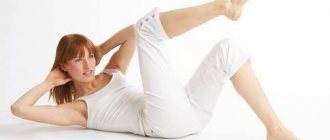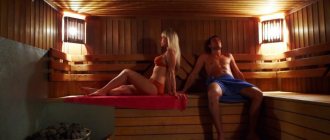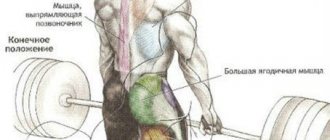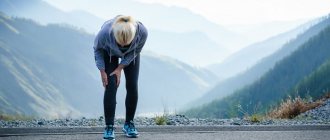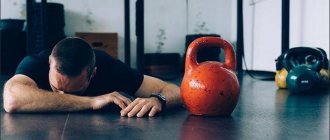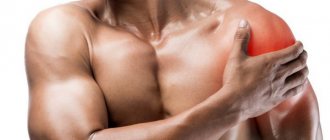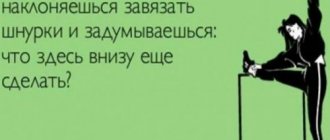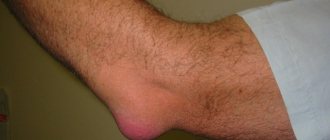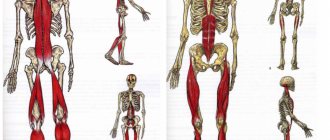Why do my arms hurt after training?
It is believed that only beginners can get sore muscles after training, but this is not true. Let's figure out where the unpleasant sensations come from.
For beginners
If you trained for the first time, your body has experienced stress, and your arm muscles begin to ache a lot. During exercise, lactic acid is released, which is a by-product of the body's activity - it is what causes the burning sensation.
Surely you are familiar with the situation when, after intense exercise, you want to quickly let your body relax, and then, after a few minutes of rest, you get up and begin to straighten your arms - the pain in your biceps becomes simply unbearable.
This happens because during training only part of the lactic acid is excreted, while the rest stagnates in the muscles and causes discomfort until it is completely eliminated. This is the feeling that they say “your hands are pounding.”
Conclusion: to feel good, you need to move. The best method for resolving acid is stretching, which hudeem-bez-problem.ru will tell you about a little later.
Question: Is it normal for arm pain after exercise?
Answer: Pleasant arm fatigue or mild pain that goes away a few hours after training is considered normal.
If you are experiencing delayed pain, it means you have overdone it and chosen a program that is too intense.
Arm and shoulder muscles become inflamed during intense workouts
Pain the next day
As a rule, the morning after the first few workouts it is very difficult to do anything with your hands, since they hurt much more than yesterday.
About muscle soreness after training >>
During excessive exercise, muscle fibers are injured and micro-tears appear, which become inflamed and cause severe pain the day after exercise. This is called delayed pain.
Delayed pain should not scare you, because the body is just responding to the stress and overexertion that you received, causing the body to feel an unusual load.
For experienced athletes
Many people believe that if your hands don’t hurt after a workout, then it was in vain.
The absence of pain and discomfort indicates that your muscles are toned and they are ready for work and defense around the clock.
For athletes who are interested in gaining muscle mass, this should be a wake-up call: they exercise with the same load, and their body is in a comfort zone. To start muscle growth processes, the load needs to be gradually increased.
Pain due to injury
This type of pain is the most dangerous and requires immediate action. Painful sensations from arm muscle injuries have characteristic symptoms, so a person understands the occurrence of a problem almost immediately. They are characterized by the following features:
- sudden onset of pain;
- localization of a point nature;
- discomfort that does not go away for a long time;
- inability to continue training;
- external changes in the injured area, in the form of swelling, the appearance of an uncharacteristic skin tone, and an increase in its temperature.
Pain from injuries can be intermittent and only appear when the athlete tries to do certain types of exercise. If such signs appear, it is recommended to immediately seek medical help. Experts do not advise delaying visiting a doctor and doing this even if there is a suspicion of an injury to the arm muscles.
Why don't my arms straighten after training?
Most often, this disease affects the elbow joint.
- The most common cause is muscle spasm, which is accompanied by poor circulation and oxygen starvation. Due to this, lactic acid accumulates, a burning sensation appears and muscles contract. If after training you cannot straighten your arms, a special massage will help relieve the spasm, but recovery may take up to ten days. Your arm will hurt for some time, reminds hudeem-bez-problem.ru, and training, of course, is out of the question.
- If you haven't warmed up well enough before training, you have every chance of getting a sprain. Due to this, you will not be able to straighten your arms from pain. Most often, your arms do not straighten after training at the elbows when you practice on your own, without a trainer, and do not carefully monitor the technique.
By making sudden movements during exercise, you increase the likelihood of such an injury.
During training, make movements smoothly, this will help avoid injury.
Self-massage and a contrast shower will help - from hot to cold.
- Another reason why the arms do not straighten after training is typical mainly for beginners - dislocation of the joint. This is also due to incorrect exercise technique. Most often, the weakest and most fragile place is affected - the wrist joint.
To recover, you should not put stress on the injured area for a couple of weeks.
Salt compresses are useful. To do this, dissolve two tablespoons of salt (it’s better to take sea salt) in a glass of water, soak a cloth or gauze in the solution and wrap it around your wrist. Place a clean, dry towel on top. The water should be cool or at room temperature - you cannot heat the dislocation, so also do not use plastic or cling film for wrapping.
Pathological causes
You should consult a doctor as soon as possible if elbow pain is accompanied by other negative symptoms. These are hematomas, swelling, limitation of movements, decreased sensitivity and/or redness of the skin, increased local or general temperature, visible deformation of the joint, and constant swelling in the morning. Any of these signs indicates:
- getting injured;
- development of inflammatory or degenerative pathology.
The sooner the doctor conducts an examination and begins treatment, the lower the risk of developing severe irreversible complications. In case of injury, therapy is usually conservative - wearing orthopedic devices that limit the load on the joint, gradual development of all structures of the elbow. Treatment of pathologies takes longer, and its success depends on the type of disease and stage of the disease.
Injuries
It is impossible not to notice an intra-articular fracture or fracture of the shoulder bone, as is a dislocation. The resulting pain is so acute that the person loses consciousness. Fractures most often occur during active sports - football, handball, athletics. Sharp pain is also a symptom of complete or partial rupture of muscles, ligaments or tendons, commonly called a sprain. To restore the integrity of these structures, both conservative treatment methods and surgical intervention can be used.
Fracture on x-ray.
No less dangerous is microtrauma of soft, cartilage, bone tissue, muscles, ligaments, and tendons. And these injuries are typical for professional athletes. As a result of intense physical activity, the integrity of individual fibers is compromised. In the future, there are more such damaged structures, which affects the functioning of the muscle or ligament.
If left untreated, including reducing the duration and intensity of training, microtraumas can cause the development of severe recurrent pathologies.
Pathologies
You should not independently identify any articular pathology; take into account only the nature of the discomfort in your elbow. Pain of varying variability occurs with arthrosis, gout, arthritis, and tendovaginitis. In acute pathologies it is cutting, stabbing, piercing, and in chronic pathologies it is aching, pressing. Only a doctor can make the correct diagnosis after conducting a series of instrumental and bacteriological studies.
There are pathologies that most often affect the elbow joints of professional athletes due to constant microtrauma of tissue:
- epicondylitis - lateral or medial. Degenerative-inflammatory disease of the elbow joint, developing at the attachment points of the tendons of the inner and outer surface of the forearm;
- tendinitis. Acute or chronic inflammatory disease in the tendon area. In the absence of treatment, it provokes the appearance of often irreversible destructive-dystrophic changes;
- Tenosynovitis. Inflammation of the tendon and its surrounding membrane. The main difference from tendinitis is the development of pathology in the area of tendons with sheaths, or soft tunnels, consisting of connective tissue.
- bursitis. Acute, subacute or chronic inflammation of the synovial bursa, accompanied by the formation and accumulation of exudate in its cavity. Acute pathology develops due to injury, chronic pathology develops due to constant mechanical irritation.
All these diseases, unlike arthrosis or arthritis, are highly treatable, and the prognosis for complete recovery is favorable.
Arthrosis can be the result of a serious sports injury or regular microtrauma. But the cause of the development of arthritis is often a dysfunction of the immune system, genetic predisposition, infection, or a significant decrease in immunity.
| Physical exercises that lead to pain in the elbow joint | The most likely causes of discomfort and accompanying symptoms |
| Flexion and extension | Arthrosis deformans, subacute or chronic bursitis, any form of arthritis. The main signs are pain that intensifies after training, swelling of the joint, redness of the skin in the elbow area. With lateral epicondylitis, discomfort appears when clenching your fists |
| Lifting weights | Subacute epicondylitis. A person is not able to hold heavy objects with outstretched arms for a long time. Painful sensations occur only during training and are absent at rest |
| Active sports (tennis, volleyball, basketball, skiing) | Microtrauma of muscles, ligaments, tendons, subluxation, lateral or medial epicondylitis, cubital tunnel syndrome. In addition to pain, the clinical picture includes swelling and stiffness of movement. |
| Pull-up on the horizontal bar | Epicondylitis, bursitis, arthritis, thoracic or cervical osteochondrosis, ulnar nerve neuritis. The pain that occurs after training is so severe that the athlete cannot start exercising within 24 hours |
Is it normal for your hands to shake after training?
Many, even experienced athletes, have trembling hands after training. The reasons are quite simple and easy to fix.
Lack of energy
Tremor usually occurs from weakness when the muscles are not in good shape.
- Sleeping poorly at night, and going to training in the morning is a bad idea, because the body has not had time to rest and recover. You simply do not have enough strength to perform the exercises, and any load will be excessive for the muscles.
- If the day before you were very nervous for some reason and clearly spent a lot of energy, then it’s also not worth forcing your body to work beyond normal and give up the remaining strength.
- The same applies to the situation when you are overtired at work, and training is next on the schedule. There is no need to waste the rest of the energy that will be used to restore the body after a hard day, advises hudeem-bez-problem.ru.
- Another reason why trembling hands may appear is an incorrectly calculated training program. Your body may not be ready for excessively heavy physical activity. Herbal preparations such as valerian, as well as rest and relaxation, will help the body restore wasted resources.
Lack of useful and nutritious substances
An unbalanced diet, as a result of which your body lacks vitamins and minerals, can also cause trembling in the hands after physical activity.
The load should be selected by a qualified trainer
If you are not able to independently create a diet for yourself that will include all the important components - proteins, fats, carbohydrates, minerals, macro and microelements, seek help from a nutritionist who works with athletes.
If everything is fine with your nutrition, but your hands shake every time after training, and your body is not in a resourceful state, consult a doctor and get tested.
It is quite possible that all the important elements do not have time to enter the blood in the required quantities, and then the doctor can help.
Common causes of pain
Coming to the gym for the first time, a novice athlete diligently performs all the exercises given to him by the coach, so that he would not be ashamed in front of the experienced “jocks”. Naturally, the body, not accustomed to such stress, responds with pain throughout the body. Beginners believe that if their whole body hurts, it means they did a great job. But this is completely the wrong approach.
After training, the athlete should feel pleasant fatigue in the muscles, but not severe pain. Let's look at what happens in the human body after heavy loads:
- if the muscles are poorly warmed up and stretched, and a person begins to work on weight training equipment, then painful sensations may appear due to microcracks in the muscles, which become inflamed over time and become very painful;
- a person may experience burning-type pain. This suggests that you have overworked yourself. The tissues produce a lot of lactic acid, which interferes with normal blood circulation. At this time, there is a deficiency of oxygen, and the muscles refuse to perform contractile movements, which leads to the fact that the elbow does not straighten after training. Most often, this problem appears after intense exercises on the biceps of the arms;
- Sprains occur during sudden movements of the arms, for example, when jerking while lifting a barbell. This happens when the athlete spent little time warming up and warming up the muscles and did not do exercises to stretch the ligaments;
- Dislocation of the joint also causes severe pain and loss of movement of the limb. Here you definitely need to contact a specialist for help;
- poor metabolism in muscle tissue. This is a chemical process that breaks down proteins, fats and carbohydrates to release the energy needed for training. This releases toxins, which are normally eliminated through the capillary network. This requires a lot of oxygen. If the release occurs slowly, then all these decay products accumulate in the tissues, which leads to pain and malfunction of the elbow joint.
What to do if your hands are swollen?
Whether you are a beginner or an experienced athlete, the likelihood of getting swelling in your hands after training is the same. Let's look at the main reasons:
- You have decided to “conquer Everest” in a short time. If the load is too high and does not correspond to the body's capabilities, you will damage the muscles and ligaments and get unpleasant swelling. This often happens with beginners who want to quickly move on to more interesting and complex exercises: they take on overwhelming training programs and torture their body. This also happens to experienced athletes, especially when there is a deadline to achieve a certain result.
- Swelling of the hands may indicate a sprain. However, you are unlikely to miss this: a sharp pain will appear before the swelling. If you realize that you have been injured, you cannot continue training, otherwise you may suffer a ligament or tendon rupture. Immobilize your hand, apply ice and visit a doctor.
- Lactic acid plays an important role here too - it is the most common cause of swollen hands. This type of swelling is quite easy to deal with: go to the bathhouse with a broom or take a bath with sea salt. A contrast shower, light exercises or self-massage will also help.
- If none of the above reasons suits you, we advise you to pay attention to your health. Edema may be accompanied by diseases of the ligaments or joints. It is unlikely that you will be able to cope with this on your own, so you should consult a doctor.
Stretching and cooling down after exercise will relax your muscles and reduce pain.
Methods for relieving muscle pain
On average, it takes 48 hours for scarring, complete healing and fiber restoration to occur. It is recommended to do the following:
- do a soft tissue massage; hydromassage should be avoided;
- take a warm bath with sea salt or essential oils for 15 minutes;
- resort to physical exercise;
- take advantage of bathing procedures in the form of a visit to the Finnish sauna;
- ensure sufficient sleep time, since recovery processes occur during the period of muscle rest;
- provide the body with a sufficient amount of “building” materials in the form of proteins, carbohydrates, vitamins and minerals;
- arrange a bath procedure.
If the muscles hurt severely and the symptoms become impossible to tolerate, then you can use an ointment or gel with an anti-inflammatory effect.
The most popular for pain relief is the use of Voltaren or Emulgel with a dosage of active ingredients in an amount of 1%. Even if the muscles hurt badly, sports experts do not recommend resorting to taking pharmacological drugs. In case of increased body temperature and severe symptoms of overexertion, you can take Ibuklin in accordance with the dosage indicated in the instructions for the drug. The drug has anti-inflammatory, analgesic, antipyretic effects and belongs to the category of non-steroidal drugs. It is recommended to resort to ointments and medications only in extreme cases.
About restoring the body after training >>
The last recommendation, in the form of the need for physical activity when muscles hurt, often causes a little surprise among novice athletes. In fact, performing a set of exercises allows you to increase blood flow in sore areas and promotes better nutrition of inflamed tissues, as a result of which the healing process is faster. This recommendation should not be used for several hours after training, since the muscles need time for basic recovery.
You should not use exercises with serious power load; to relieve pain symptoms, it is enough to perform a set of warm-up exercises. Anaerobic exercise is considered to be the most effective for removing lactic acid, so it is recommended to jog at a slow pace for 5-10 minutes, after which it is recommended to do stretching exercises.
My hands go numb - why?
Numbness is a very common symptom after exercise, but the consequences can be very unpleasant.
- If your arms were suspended long enough during the exercises, you could cause blood to flow out, which led to a lack of sensitivity. As a rule, the hands and forearms become numb first.
- Another possible cause is a disruption in the transmission of nerve impulses from the brain to other organs. May appear with a deficiency of B vitamins.
- Pinched nerves and compression of blood vessels. Possibly with osteochondrosis. If you have this disease, your training program should be drawn up based on your doctor’s recommendations, otherwise, if you handle your body carelessly, you may unknowingly destroy nerve fibers.
- Tunnel syndrome or carpal tunnel syndrome. It happens to those who work a lot at the computer. It manifests itself as numbness and immobility of the fingers or the entire hand.
- If not both arms are numb, but only the left one, this may indicate one of the cardiac diseases. In such a situation, you should stop training and consult a doctor as soon as possible.
What is contraindicated to do if there is pain?
There are a number of symptoms that signal to us that the body is not ready for training. In such cases, it is better to give them a rest and then return to the exercises with renewed vigor.
- Feeling very tired.
- Respiratory and infectious diseases.
- Exacerbation of chronic diseases.
- Increased body temperature.
Neglecting the rules of exercise or exercising with the symptoms described above means harming yourself. If the unpleasant sensations do not go away for several days, and no folk advice helps, then it will not hurt to consult a doctor. Only a doctor can determine exactly what is happening in your body and why your arms hurt after training.
Unpleasant sensations in the hands and discomfort are usually caused by muscle overstrain, unbalanced load, as well as a long break between workouts.
If the load is calculated correctly, after training a pleasant fatigue occurs in the muscles.
An important point is the mandatory warm-up, which will warm up the muscles and prepare them for more serious loads.
How to properly stretch your arms after a workout
During exercise, the muscles in your arms contract. After training, they should return to their original length, but this will take several days. To help you recover faster, stretch after every workout.
Execution rules:
- The duration should not be less than five minutes. Ideally - from fifteen to twenty. And once a week we recommend stretching for at least half an hour.
- After heavy exercise, be sure to get your heart rate back up before you start stretching your muscles. You can drink water and walk around for a couple of minutes.
- Stretching after training must be static - no sudden or springy movements. It should also be aimed at the entire body, not just the muscles you just worked.
- Watch your breathing: take a deep breath and then exhale slowly. This will set you up for relaxation.
- You should not do stretching aimed at increasing flexibility. Your task is to help the contracted muscles recover. Don't overdo it to avoid damaging tense joints.
- When bending towards your feet, do not round your back, even if you lack the dexterity. Keep it straight to avoid damaging your spine.
- You can add a massage roller to the stretching; this will replace self-massage.
- Remember that there should be no pain! The exercises should be performed until there is slight discomfort, after which you will feel pleasant relaxation.
Treatment options
Often people who constantly have pain in the tendons of their hands look for ways to get rid of these symptoms on their own. Home treatment and the use of traditional medicine can have a positive result only if the doctor approves this approach. For any problems that allegedly affect the tendons of the hand, you should contact a medical facility. Any disease of tendon tissue creates a risk of its degeneration and the onset of degenerative processes that may become irreversible.
To clarify the diagnosis, the doctor may prescribe an MRI, but more often the disease can be recognized by interviewing the patient, as well as examining him and palpating the affected area.
- Classic approaches to treatment involve the first stage of taking painkillers (in the form of tablets, suspensions, injections), as well as immobilization. Immobilization is achieved using elastic bandages or splints or even plaster.
- Additionally, anti-inflammatory ointments, as well as creams and gels are used.
- Nutrition adjustments are being made. Vitamins are prescribed (with particular emphasis on ascorbic acid, as well as B12).
- After 3-5 days, physical therapy is prescribed. At the same time, immobilization is maintained. Removal of the fixator from the hand is allowed no earlier than 10 days. In this case, the main condition is that the tendons should stop hurting by this moment.
- After removing the immobilization fixation (plaster, splint), the patient is prescribed an individual course of therapeutic exercises. All exercises are performed 2-3 times a day, regularly, for a week or more.
- Since diseases of the tendon tissue cause microtrauma and inflammatory processes, during the period of treatment the patient is exempt from work or educational activities, he is prohibited from physical activity and any stress on the area of the affected joint.
- For tendinitis, cooling compresses are additionally prescribed. Tenosynovitis, on the contrary, requires warming.
- The most radical and rarely used treatment method is surgery. In some cases, due to the heavy work of the joint areas when tenosynovitis develops, the problem can become serious, requiring the removal of pus from the inflamed tendon sheaths.
After completion of treatment, the patient needs rest for about 1-2 weeks.
Identifying the cause
You can understand the true reason why your arm does not straighten at the elbow after training after consulting a doctor. If the pain is temporary, then proper organization of loads and a good warm-up before the main activity will help. After training, it is advisable to massage the limb and rub the muscles to get rid of lactic acid in the tissues.
A hot shower will help you relax, and salt baths will help relieve stress and inflammation from your elbow. If the pain is severe and prolonged, then there is no need to hesitate; it is better to go to a therapist and check the condition of the joint.
